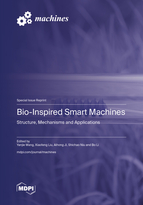Bio-Inspired Smart Machines: Structure, Mechanisms and Applications
A special issue of Machines (ISSN 2075-1702). This special issue belongs to the section "Bioengineering Technology".
Deadline for manuscript submissions: closed (30 September 2022) | Viewed by 43814
Special Issue Editors
Interests: advanced bionics systems and robotics; smart materials and structures; polymer-based sensors and actuators
Special Issues, Collections and Topics in MDPI journals
Interests: natural navigation; human–computer interaction; multimedia monitoring and observation of behavioral ecology
Interests: intelligent robots; motion bionics and mechanics; mechatronics tech
Special Issues, Collections and Topics in MDPI journals
Interests: bionic soft robots; bionic mechanical sensors; bionic anti-fog and anti-reflection functional surfaces and materials
Special Issues, Collections and Topics in MDPI journals
Interests: dielectric elastomer actuators and artificial muscle; active multi-stable mechanisms and compliant robots; camouflage discoloration technology based on bionic photonic crystals
Special Issues, Collections and Topics in MDPI journals
Special Issue Information
Dear Colleagues,
With the long-term evolution of nature, each creature has its unique structure and function, which can adjust to unstructured environments with diversity. These structures, mechanisms, and potential principles from biology will definitely excite new ideas for improving and optimizing conventional machine designs and control. By imitating certain characteristics of these creatures, such as grasp, twist, locomotion, or flying, etc., bio-inspired smart machines can engage in certain difficult tasks instead of human beings, such as medical surgery, rapid manufacture and assembly, disaster search and rescue, and scientific investigation. Therefore, bio-inspired smart machines have important research significance and broad developmental prospects.
Generally, bio-inspired smart machines can be divided into two categories: rigid machines and soft machines. Rigid machines are composed of different rigid components assembled together, and the joints are mainly driven by electric motors or hydraulic means. In soft machines, the rigid hinges and bolts together with the body structure are replaced by soft components usually made from stimulus-responsive materials that change shape in response to stimuli.
This Special Issue will be devoted to state-of-the-art research on bio-inspired smart machines and their subsystems and components, such as bio-inspired rigid machines, soft machines and robotics, active materials, controls, sensors and actuators, structure and modeling, etc. We seek submissions with original perspectives and advanced thinking on the theme addressed. Related research on theories, simulations, experiments, and engineering applications is also welcome.
Prof. Dr. Yanjie Wang
Prof. Dr. Xiaofeng Liu
Prof. Dr. Aihong Ji
Prof. Dr. Shichao Niu
Dr. Bo Li
Guest Editors
Manuscript Submission Information
Manuscripts should be submitted online at www.mdpi.com by registering and logging in to this website. Once you are registered, click here to go to the submission form. Manuscripts can be submitted until the deadline. All submissions that pass pre-check are peer-reviewed. Accepted papers will be published continuously in the journal (as soon as accepted) and will be listed together on the special issue website. Research articles, review articles as well as short communications are invited. For planned papers, a title and short abstract (about 100 words) can be sent to the Editorial Office for announcement on this website.
Submitted manuscripts should not have been published previously, nor be under consideration for publication elsewhere (except conference proceedings papers). All manuscripts are thoroughly refereed through a single-blind peer-review process. A guide for authors and other relevant information for submission of manuscripts is available on the Instructions for Authors page. Machines is an international peer-reviewed open access monthly journal published by MDPI.
Please visit the Instructions for Authors page before submitting a manuscript. The Article Processing Charge (APC) for publication in this open access journal is 2400 CHF (Swiss Francs). Submitted papers should be well formatted and use good English. Authors may use MDPI's English editing service prior to publication or during author revisions.
Keywords
- bio-inspired theories and principles of biological mechanisms
- bio-inspired motions and functions
- bio-inspired active materials and structures
- bio-inspired sensors or actuators
- bio-inspired rigid machines and robots
- bio-inspired soft machines and robotics
- bio-inspired design and modeling
- bio-inspired learning and control
- bio-inspired human–robot interactions
- bio-inspired machine applications










